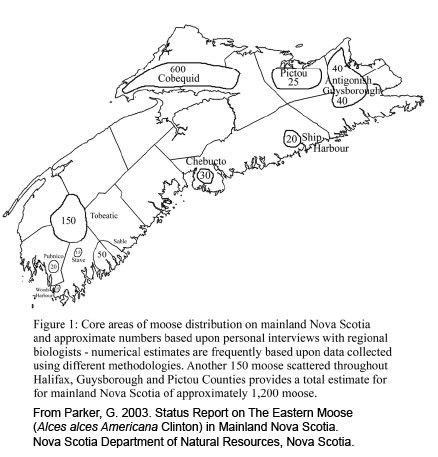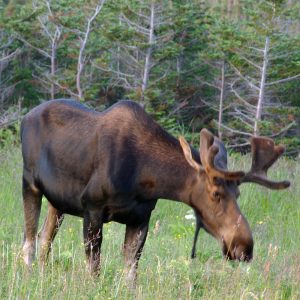One is about the 51st North American Moose Conference which is being held over 5 days (Aug 28 – Sept. 1) at the Celtic Lodge in Ingonish, Cape Breton. The theme is “Hyper-Abundant Moose Populations – Ecological Consequences and Management Strategies.
Infrared moose tracking will be just one of the topics up for discussion at the 51st North American Moose Conference this week in Nova Scotia. An expert from the northeastern U.S. will discuss how infrared aerial tracking can be used to detect moose, even under a dense forest canopy. The setting for the conference is the Cape Breton Highlands National Park, a place where the burgeoning moose population has taken a toll on the area’s forests…Moose in Cape Breton have destroyed about 11 per cent of the forest due to the species’ vigorous feeding on young coniferous trees. – CBC, Aug 28, 2017
The second concerns illegal hunting of moose on Hunter’s Mountain in Cape Breton under the guise of non-licensed but permitted hunting by Nova Scotia Mi’kmaq.
Last October, We’koqma’q Chief Rod Googoo, the assembly’s lead chief for lands, wildlife and forestry, called on the province to step up enforcement on Hunter’s Mountain in Victoria County, west of Baddeck, after discovering what he called a “free-for-all…Earlier this week, the assembly issued a community notice saying the province had agreed to its request for increased enforcement and that Nova Scotia band status cards would be the only ID accepted as of Aug. 15. – Tom Ayers in the Chronicle Herald, Aug 31, 2017
UPDATE SEP 16, 2017: Conservation officials answer Mi’kmaq calls for better moose-hunting patrols. Wendy Martin, CBC News Sep 15, 2017.
Patrols will increase once the non-native moose hunt opens on Sept. 25 [2017] Googoo says he thinks the initiative has already helped discourage illegal hunting, because word is out that officers are checking for status cards. “It’s wonderful,” he said. “Looking down the road, we want to make sure that we conserve, so our children and grandchildren will be able to enjoy the same things that we enjoy today.”
In contrast to concerns about over-abundance, we hear often about moose being endangered in Nova Scotia. The endangered moose are the “Mainland Moose“, which are a different subspecies (Eastern Moose, Alces alces subspecies americana) from the Cape Breton moose – those are Northwestern Moose (Alces alces subspecies andersoni).
Eastern moose occur also in New Brunswick, and were introduced to Newfoundland in 1904. Eastern moose went locally extinct in Cape Breton in the 1800s; the current population of moose in C.B. is derived from eighteen northwestern moose that were moved to Cape Breton Highlands National Park from Island National Park, Alberta in 1947/48.
It is estimated that there were 15,000 eastern moose in Nova Scotia when the Europeans arrived. Hunting reduced the number greatly by the mid-1800s. Some restrictions on hunting were introduced in 1875 and the population increased for a period but then a decline began that continued until today in spite of a total ban on hunting since 1937. The reasons are not well understood but involve a number of factors including increased incursion into wilderness moose habitat by forestry roads, mortality from a brainworm common to white-tailed deer, unidentified viral infection, high levels of the heavy metal cadmium, loss of older growth conifer habitat to forest harvesting, climate warming and acid rain. Today they number 1000-1200, distributed in nine core areas on the mainland. (Source: STATUS REPORT on The Eastern Moose (Alces alces americana Clinton) in Mainland Nova Scotia by Gerry Parker 2003)

The Mainland Moose was declared legally endangered in 2003.
Earlier this year, word of a “moose sex corridor” made the news. This refers to efforts by the Nature Conservancy of Canada to protect land on the Chignecto Isthmus, the piece of land at the neck of the peninsula that is Nova Scotia, in order facilitate movement of moose and genetic exchange between eastern moose in Nova Scotia where numbers are precariously low, and the much more numerous eastern moose in New Brunswick.
Also very topical is the use of a mechanical moose used by NSDNR to catch poachers. Its name: Bullwinkle!
In 2005, NSDNR adopted a new enforcement tool aimed at catching moose poachers. Since then, nine arrests have been made using life-sized robotic moose decoys named, ‘Bullwinkle’. Education and public awareness about the status of the mainland moose population combined with the knowledge that theses tools are being employed by the NSDNR serves as a deterrent for ‘would be’ poachers. Due to the covert nature of poaching it is difficult to determine with confidence how many mainland moose are illegally killed in any given area or season. – From Recovery Plan for Moose (Alces alces americana) in Mainland Nova Scotia (March 2007).
According to one report a father and son were each fined $8,100 for shooting at Bullwinkle; the dad lost his hunting privileges for 10 years, the son for 20 years. I can imagine the embarrasment of the publicity around it was their worse punishment!
As a resident of Peninsular Halifax I consider my Bioregion to be the Chebucto Peninsula, the chunk of land below a line drawn from the top of Bedford Basin to the top of St. Margaret’s Bay. (Halifax is considered a sub-peninsula of the Chebucto Peninsula). It is home to a group of 20-30 mainland moose. I have yet to see one in that area, but I know lots of residents who have, and on my more remote hikes I often encounter moose droppings and moose prints.
 Regardless of whether I ever see a mainland moose on the Chebucto Peninsula, I am just happy to know they are there, and that a large chunk of land on the Chebucto Peninsula is protected from major incursions on their habitat: approximately 29% of the land is now in Parks and Protected Areas (versus 12-13% for the province as a whole, 15% for HRM as a whole) and an additional 12% is Crown and Halifax Regional Municipality land that remains undeveloped. Highway 103 constitutes a significant barrier to movement of moose (and some other species) on and off of the Chebucto Peninsula which has been recognized in early documents related to the developing Halifax Green Network Plan.
Regardless of whether I ever see a mainland moose on the Chebucto Peninsula, I am just happy to know they are there, and that a large chunk of land on the Chebucto Peninsula is protected from major incursions on their habitat: approximately 29% of the land is now in Parks and Protected Areas (versus 12-13% for the province as a whole, 15% for HRM as a whole) and an additional 12% is Crown and Halifax Regional Municipality land that remains undeveloped. Highway 103 constitutes a significant barrier to movement of moose (and some other species) on and off of the Chebucto Peninsula which has been recognized in early documents related to the developing Halifax Green Network Plan.
I have some hope that one day we will see a “Chebucto Moose Sex Corridor” crossing below or over Highway 103.
Links
Related to the C.B Moose
UPDATE (Dec 12, 2017): Meat from Cape Breton moose cull used to fight poverty in First Nations
Jim Weeks, CBC Dec 8, 2017
Annual moose conference draws scientists from around Canada and U.S.
Hal Higgins, CBC News Aug 28, 2017
Mi’kmaq take control of moose harvest on Hunter’s Mountain
Tom Ayers in the Chronicle Herald, Aug 31, 2017
Albino moose killing in Cape Breton outrages Mi’kmaq
CBC Bews, Oct 7, 2013
Parks Canada Moose Reduction Program
An overview, and access to the Full Plan. Also see The Moose – Our Largest Herbivore
Bring Back the Boreal
Section on the Cape Breton Highlands National Park website.
Tiam Mi’kmaq Ecological Knowledge: Moose in Unama’ki
Written by Nadine Lefort with Clifford Paul, Ernest Johnson, and Charlie Dennis
Unama’ki Institute of Natural Resources 2014
Mi’kmaw Traditional Hunt: Why it’s Different from a Cull
Chief Rod Googoo December 1, 2015
Related to the Mainland Moose
NOVA SCOTIA NATURALLY: Mainland moose decline due to poor forest management
Bob Bancroftin the Chronicle Herald, March 9, 2015
Moose sex corridor for endangered population expands to 1,200 hectares
Mar 02, 2017 CBC
Species at Risk Guide (Nova Scotia): Eastern Moose Alces alces americana (Mainland Population)
Species At Risk Canada
STATUS REPORT on The Eastern Moose (Alces alces americana Clinton) in
Mainland Nova Scotia
by Gerry Parker for NSDNR, 2003
Recovery Plan for Moose (Alces alces americana) in Mainland
Nova Scotia
Endangered Species Act Recovery Plan Series, NSDNR 2007
The Bluff Trail: Moose and Corridors 1 | Moose and Corridors II
The Bluff Wilderness Hiking Trail lies in the Five Bridge Lakes Wilderness Area on the Chebucto Peninsula. Hikers have reported seeing moose on the more remote sections of the trail.

